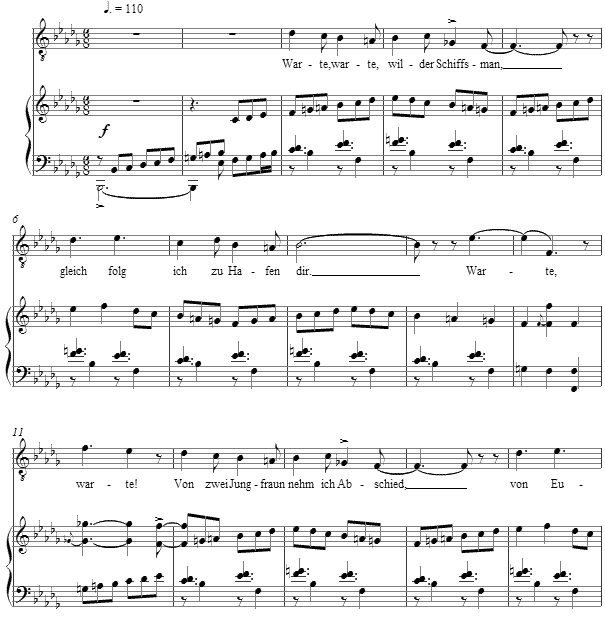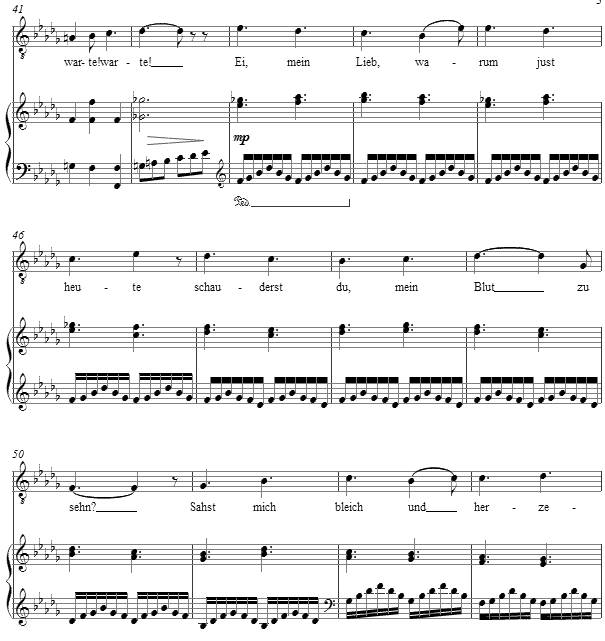Music and Texts of GARY BACHLUND
Vocal Music | Piano | Organ | Chamber Music | Orchestral | Articles and Commentary | Poems and Stories | Miscellany | FAQs
Nehm ich Abscheid - (2007)
Heinrich Heine
for tenor or baritone and piano
Warte, warte, wilder Schiffsmann,
Gleich folg ich zum Hafen dir;
Von zwei Jungfraun nehm ich Abschied,
Von Europa und von Ihr.
Blutquell, rinn aus meinen Augen,
Blutquell, brich aus meinem Leib,
Dass ich mit dem heißen Blute
Meine Schmerzen niederschreib.
Ei, mein Lieb, warum just heute
Schauderst du, mein Blut zu sehn?
Sahst mich bleich und herzeblutend
Lange Jahre vor dir stehn!
Kennst du noch das alte Liedchen
Von der Schlang im Paradies,
Die durch schlimme Apfelgabe
Unsern Ahn ins Elend stiess?
Alles Unheil brachten Äpfel!
Eva bracht damit den Tod,
Eris brachte Trojas Flammen,
Du brachtst beides, Flamm und Tod.[ 7 pages, circa 2' 20" ]
Heinrich Heine
Heine wrote, "There are more fools in the world than there are people." It has been said that love is foolish, and blind as well. For men, sometimes the decision to leave a loving relationship is wise and sometimes it is stupid, but nevertheless it is usually traumatic. This short poem captures the turmoil and anger, wildly overstated with comparisons to myths, and yet there is a truth to the experience, wherein the decision to flee is bolstered by justifications aplenty. Heine has captured this, by which we know something more of his own life experiences.
The text better known by its first line, "Warte, warte, wilder Schiffsmann," but the whole story is not only of asking the sailor to wait to go together to the harbor, but the taking leave of a woman and a place which he calls another "young woman." Therefore I chose the title elsewhere within the text itself. The setting is for a man's voice, originally conceived for tenor, and available also in an edition for baritone, as below.
The opening gesture is one of "boiling up" as the line ascends from an initial bass note forte. The occasional hemiola dancing between the 6/8 meter and a triple metrical rhythm as counterpoint is decoration to the forward moving, dupled-metered thrust of the setting.
In a simple strophic form, the setting is A-A-B-A with a short reprise of the B texture and gestures for a coda. The B section has lyrical phrases accompanied by and undercurrent of sixteenth notes all with in one single tonal region, the submediant of the minor tonic, for as angry as is our character, Heine makes him uses "loving" terms in addressing her -- or them, as one thinks of this man leaving Lady Europe as well.
To express the frustration of the moment and the calling out to the sailor to bring him to the harbor, a snippet of the B section's texture and harmonic color extends time for a moment and drives forward to the final rising cadence, noted as without slowing.
The score for Nehm ich Abschied is available as a free PDF download, though any major commercial performance or recording of the work is prohibited without prior arrangement with the composer. Click on the graphic below for this piano-vocal score in either the edition for tenor or baritone.




